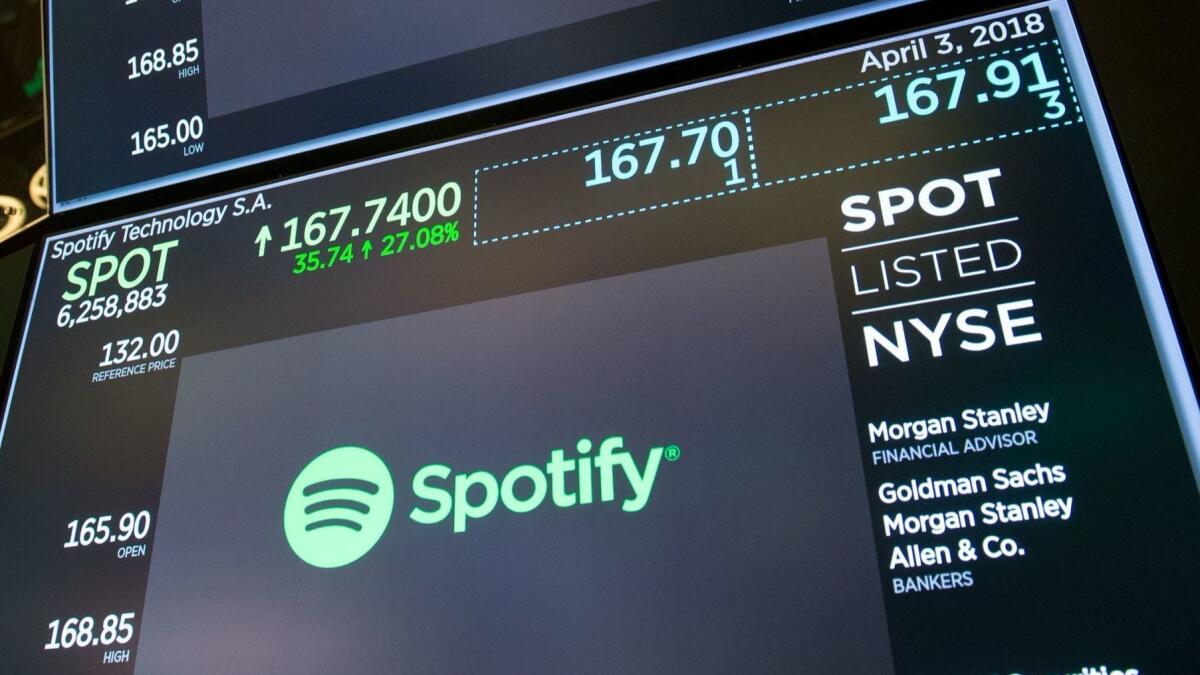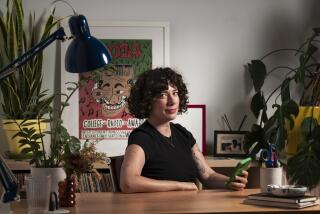Spotify’s non-IPO: The company wanted a calm stock-market debut, and that’s what it got

- Share via
It took more than three hours Tuesday to get Spotify trading publicly, in a stock sale as unorthodox as streaming digital music once seemed.
Spotify Technology SA’s shares — sold via a direct listing rather than a traditional initial public offering — finally opened at $165.90 apiece, with 5.6-million shares changing hands at that initial price, according to data compiled by Bloomberg.
They closed about 10% below the opening price, at $149.01 each, valuing the startup at almost $27 billion.
The modest moves could be seen as a sign that London-based Spotify got its wish to avoid a tumultuous debut. A successful first day of trading for the 10-year-old company was never going to be judged on whether shares jumped 30%, which is the usual benchmark for a triumphant IPO. Instead, Spotify and its advisors wanted a more mundane outcome for its unusual listing, people familiar with the matter said before the shares started trading.
Yet questions are already being asked about whether the market valuation is sustainable, given that the price was set by a relatively small number of shares changing hands. Only about 30 million shares had traded as of 1:08 p.m. PDT, shortly after the end of the regular trading day. Since there are no restrictions on investors selling, more than 100 million tradable shares are available in the market.
Before the listing, Spotify’s best-case scenario was for modest intraday movement with trading volume similar to a typical IPO, in which 50% to 100% of tradable shares change hands, the people said. The worst would have been a stock that swung wildly or lacked the available shares to trade smoothly.
Atypical approach
The atypical approach to trading is indicative of Spotify’s attitude to going public. The company has avoided the traditional IPO route at every stage. Instead of hoping for a first-day bump, its goal was to have the stock look as if it would on a run-of-the-mill day — with shares trading efficiently with little volatility as soon as possible.
One key goal before the listing was to get existing shareholders who want to sell to agree to do so quickly, even before the opening price was set, the people said. That would help manage volatility and generate sufficient supply to ward off a liquidity squeeze, which could lead to a shortage of shares and a run-up in the price.
At their opening price, shares traded well above the $48.93-to-$132.50 range at which they had changed hands in private trades this year, according to a company filing. Compared with the $132-a-share reference price — a number set by the New York Stock Exchange that doesn’t denote an offering price or valuation, but is necessary to open the shares — the stock rose as much as 28%.
As the company prepared to go public, Chief Executive Daniel Ek made clear that Spotify chose a direct listing to avoid “the pomp and circumstance” of an IPO. Still, the company has drummed up the most noise around a non-IPO listing since Google Inc. sold stock in a Dutch auction, in which investors submitted bids over the internet, fax and telephone. And Spotify is poised to be of a comparable size as the search behemoth was when it listed.
The listing crystallized 10-figure fortunes for co-founders Ek and Martin Lorentzon. Ek had a net worth of about $2.4 billion and Lorentzon had $3.4 billion as of 11:15 a.m., according to the Bloomberg Billionaires Index.
On the demand side of the equation, there are a number of reasons for investors to get excited about being able to buy the stock. Spotify offers investors their best opportunity to invest in the music business, which recently has rebounded from 15 years of decline. All three major record labels are either private or owned by large conglomerates, while Pandora Media Inc., owner of the world’s largest online radio service, is valued at just $1.2 billion.
Viable business
Spotify can claim a lot of credit for the industry’s recovery. Paid streaming accounted for 40% of U.S. music industry sales last year. Spotify also offers a free service, but that accounts for a small fraction of its revenue. Spotify posted revenue of $5 billion last year, up 39% from a year earlier. Yet it must still prove to investors that a music service can be a viable business. Losses have grown in each of the last three years, reaching about $1.5 billion in 2017, due in large part to the royalties paid to music rights holders.
The company was able to tell its story in a pre-listing investor day where it gave financial guidance, but it didn’t host the roadshow typical in a regular IPO. Spotify also skipped another key process in an IPO, in which a set number of shares are sold at a specific price to a known list of investors before trading starts. Instead, the company’s first public share price was determined after the opening bell by the supply of shares that existing holders are willing to sell, as well as by demand for those shares.
Spotify and its advisors couldn’t control every step of the process. The company went public after weeks of volatile trading conditions for tech companies; indexes were roiled by fears of a trade war and by President Trump’s rhetoric against Amazon.com Inc. Still, markets played nice Tuesday, with U.S. stocks rebounding from seven-week lows despite continued volatility.
No guarantee
Spotify’s stock got off the ground with the help of advisors Goldman Sachs Group Inc., Morgan Stanley and Allen & Co. and designated market maker Citadel Securities LLC.
The advisors had to work a long list of existing investors to try to discern whether they might sell and at what price, with no guarantee that they wouldn’t change their minds on listing day. Those conversations with investors — venture capitalists, institutional investors and family offices — took more than six weeks, the people said.
They did the same with potential buyers, the people said. In addition to the familiar conversations about share price, they discussed the process itself and how to get shares in a tradable format, with buyers and sellers having the correct accounts.
UPDATES:
4:10 p.m.: This article was updated throughout with the stock’s closing price, context, analysis and additional details.
This article was originally published at 11:55 a.m.
More to Read
Inside the business of entertainment
The Wide Shot brings you news, analysis and insights on everything from streaming wars to production — and what it all means for the future.
You may occasionally receive promotional content from the Los Angeles Times.










